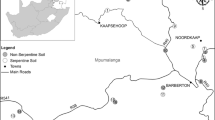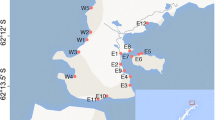Abstract
Pyrosequencing and quantitative polymerase chain reaction of small subunit rRNA genes were used to provide a comprehensive examination of bacterial, cyanobacterial, and eukaryotic communities in the biological soil crusts (BSCs) of Gurbantünggüt Desert sand dunes (China). Three succession stages were recognized based on the analyses of eukaryotic communities: a late succession stage of BSCs in a swale with eukaryotes mainly related to the Bryophyta clade, an initial succession stage in a slope with barely any eukaryotic phototrophic microorganisms detected, and an intermediate succession type detected from both the swale and slope BSCs dominated by the phylum Chlorophyta. Moreover, the cyanobacterial community dominated all of the BSCs (48.2–69.5 % of the total bacteria) and differed among the three succession stages: sequences related to Microcoleus steenstrupii and the genus Scytonema were abundant in the later succession stage, whereas both the initial and intermediate stages were dominated by Microcoleus vaginatus. Compared with swales, BSCs from slopes are exposed to a harsher environment, e.g., higher irradiance and lower water availability, and thus may be restricted from developing to a higher succession stage. Other disturbances such as wind and grazing may explain the different succession stages observed in swales or slopes. However, no clear differences were detected from non-phototrophic bacterial communities of the three succession stages, and sequences related to Alphaproteobacteria and Actinobacteria were most abundant in all the BSCs. The closest matches for the most frequent non-phototrophic bacterial genera were mainly derived from harsh environments, indicating the robustness of these genera.






Similar content being viewed by others
Abbreviations
- BSCs:
-
Biological soil crusts
- qPCR:
-
Quantitative polymerase chain reaction
References
Abed RMM et al (2008) Lipid biomarkers, pigments and cyanobacterial diversity of microbial mats across intertidal flats of the arid coast of the Arabian Gulf (Abu Dhabi, UAE). FEMS Microbiol Ecol 65:449–462
Abed RMM, Al Kharusi S, Schramm A, Robinson MD (2010) Bacterial diversity, pigments and nitrogen fixation of biological desert crusts from the Sultanate of Oman. FEMS Microbiol Ecol 72:418–428
Abed RMM, Ramette A, Hübner V, Deckker P, Beer D (2012) Microbial diversity of eolian dust sources from saline lake sediments and biological soil crusts in arid Southern Australia. FEMS Microbiol Ecol 80:294–304
Bates ST, Nash TH III, Sweat KG, Garcia-Pichel F (2010) Fungal communities of lichen-dominated biological soil crusts: diversity, relative microbial biomass, and their relationship to disturbance and crust cover. J Arid Environ 74:1192–1199
Bates ST, Clemente JC, Flores GE, Walters WA, Parfrey LW, Knight R, Fierer N (2012) Global biogeography of highly diverse protistan communities in soil. ISME J 7:652–659
Belnap J (2002) Nitrogen fixation in biological soil crusts from southeast Utah, USA. Biol Fert Soils 35:128–135
Belnap J (2003) The world at your feet: desert biological soil crusts. Front Ecol Environ 1:181–189
Belnap J (2006) The potential roles of biological soil crusts in dryland hydrologic cycles. Hydrol Process 20:3159–3178
Belnap J, Gardner JS (1993) Soil microstructure in soils of the Colorado Plateau: the role of the cyanobacterium Microcoleus vaginatus. West N Am Naturalist 53:40–47
Belnap J, Phillips SL, Miller ME (2004) Response of desert biological soil crusts to alterations in precipitation frequency. Oecologia 141:306–316
Belnap J, Phillips SL, Flint S, Money J, Caldwell M (2008) Global change and biological soil crusts: effects of ultraviolet augmentation under altered precipitation regimes and nitrogen additions. Glob Change Biol 14:670–686
Bråte J, Logares R, Berney C, Ree DK, Klaveness D, Jakobsen KS, Shalchian-Tabrizi K (2010) Freshwater Perkinsea and marine–freshwater colonizations revealed by pyrosequencing and phylogeny of environmental rDNA. ISME J 4:1144–1153
Bremner J, Mulvaney C (1982) Nitrogen—total. In: Page AL (ed) Methods of Soil American Society of Agronomy. Madison, Wl, pp 595–624
Büdel B et al (2009) Southern African biological soil crusts are ubiquitous and highly diverse in drylands, being restricted by rainfall frequency. Microbiol Ecol 57:229–247
Chen LZ, Li DH, Song LR, Hu CX, Wang GH, Liu YD (2006) Effects of salt stress on carbohydrate metabolism in desert soil alga Microcoleus vaginatus Gom. J Integr Plant Biol 48:914–919
Csotonyi JT, Swiderski J, Stackebrandt E, Yurkov V (2010) A new environment for aerobic anoxygenic phototrophic bacteria: biological soil crusts. Environ Microbiol Rep 2:651–656
Dunbar J et al (2012) Common bacterial responses in six ecosystems exposed to 10 years of elevated atmospheric carbon dioxide. Environ Microbiol 14:1145–1158
Fan LL, Tang LS, Wu LF, Ma J, Li Y (2014) The limited role of snow water in the growth and development of ephemeral plants in a cold desert. J Veg Sci 25:681–690
Garcia-Pichel F, Belnap J (2001) Small-scale environments and distribution of biological soil crusts. In: Belnap J (ed) Biological soil crusts: structure, function, and management. Springer, Berlin Heidelberg, pp 193–201
Garcia-Pichel F, Lopez-Cortes A, Nubel U (2001) Phylogenetic and morphological diversity of cyanobacteria in soil desert crusts from the Colorado Plateau. Appl Environ Microbiol 67:1902
Garcia-Pichel F, Loza V, Marusenko Y, Mateo P, Potrafka RM (2013) Temperature drives the continental-scale distribution of key microbes in topsoil communities. Sci 340:1574–1577
Gtari M et al (2012) Contrasted resistance of stone-dwelling Geodermatophilaceae species to stresses known to give rise to reactive oxygen species. FEMS Microbiol Ecol 80:566–577
Gundlapally SR, Garcia-Pichel F (2006) The community and phylogenetic diversity of biological soil crusts in the Colorado Plateau studied by molecular fingerprinting and intensive cultivation. Microbiol Ecol 52:345–357
Hallmann C, Stannek L, Fritzlar D, Hause-Reitner D, Friedl T, Hoppert M (2013) Molecular diversity of phototrophic biofilms on building stone. FEMS Microbiol Ecol 84:355–372
Housman D, Powers H, Collins A, Belnap J (2006) Carbon and nitrogen fixation differ between successional stages of biological soil crusts in the Colorado Plateau and Chihuahuan Desert. J Arid Environ 66:620–634
Hu C, Zhang D, Huang Z, Liu Y (2003) The vertical microdistribution of cyanobacteria and green algae within desert crusts and the development of the algal crusts. Plant Soil 257:97–111
Jacobs AFG, Heusinkveld BG, Berkowicz SM (2000) Dew measurements along a longitudinal sand dune transect, Negev Desert, Israel. Int J Biometeorol 43:184–190
Joe MM, Saravanan VS, Sa TM (2013) Aggregation of selected plant growth promoting Methylobacterium strains: role of cell surface components and hydrophobicity. Arch Microbiol 195:219–225
Karsten U, Friedl T, Schumann R, Hoyer K, Lembcke S (2005) Mycosporine-like amino acids and phylogenies in green algae: Prasiola and its relatives from the Trebouxiophyceae (Chlorophyta). J Phycol 41:557–566
Karsten U, Lütz C, Holzinger A (2010) Ecophysiological performance of the aeroterrestrial green alga klebsormidium crenulatum (Charophyceae, Streptophyta) isolated from an alpine soil crust with an emphasis on desiccation stress. J Phycol 46:1187–1197
Kidron GJ, Vonshak A, Dor I, Barinova S, Abeliovich A (2010) Properties and spatial distribution of microbiotic crusts in the Negev Desert, Israel. Catena 82:92–101
Lan SB, Wu L, Zhang D, Hu CX, Liu Y (2010) Ethanol outperforms multiple solvents in the extraction of chlorophyll-a from biological soil crusts. Soil Biol Biochem 43:857–861
Lan SB, Wu L, Zhang DL, Hu CX (2013) Assessing level of development and successional stages in biological soil crusts with biological indicators. Microbiol Ecol 66:394–403
Lane D (1991) 16S/23S rRNA sequencing. In: Stackebrandt E (ed) Nucleic acid techniques in bacterial systematics. Wiley, Chichester, pp 115–147
Lange O, Kidron G, Budel B, Meyer A, Kilian E, Abeliovich A (1992) Taxonomic composition and photosynthetic characteristics of thebiological soil crusts’ covering sand dunes in the western Negev Desert. Funct Ecol 6:519–527
Langhans TM, Storm C, Schwabe A (2009) Community assembly of biological soil crusts of different successional stages in a temperate sand ecosystem, as assessed by direct determination and enrichment techniques. Microbiol Ecol 58:394–407
Lauber CL, Hamady M, Knight R, Fierer N (2009) Pyrosequencing-based assessment of soil pH as a predictor of soil bacterial community structure at the continental scale. Appl Environ Microbiol 75:5111–5120
Li K, Liu RY, Zhang HX, Yun JL (2013) The diversity and abundance of bacteria and oxygenic phototrophs in saline biological desert crusts in Xinjiang, Northwest China. Microbiol Ecol 66:40–48
Meadow JF, Zabinski CA (2012) Spatial heterogeneity of eukaryotic microbial communities in an unstudied geothermal diatomaceous biological soil crust: Yellowstone National Park, WY, USA. FEMS Microbiol Ecol 82:182–191
Muyzer G, De Waal EC, Uitterlinden AG (1993) Profiling of complex microbial populations by denaturing gradient gel electrophoresis analysis of polymerase chain reaction-amplified genes coding for 16S rRNA. Appl Environ Microbiol 59:695–700
Nagy ML, Perez A, Garcia-Pichel F (2005) The prokaryotic diversity of biological soil crusts in the Sonoran Desert (Organ Pipe Cactus National Monument, AZ). FEMS Microbiol Ecol 54:233–245
Nubel U, Garcia-Pichel F, Muyzer G (1997) PCR primers to amplify 16S rRNA genes from cyanobacteria. FEMS Microbiol Ecol 63:3327–3332
Pruesse E, Quast C, Knittel K, Fuchs BM, Ludwig W, Peplies J, Glöckner FO (2007) SILVA: a comprehensive online resource for quality checked and aligned ribosomal RNA sequence data compatible with ARB. Nucleic Acid Res 35:7188–7196
Rivera-Aguilar V, Godinez-Alvarez H, Manuell-Cacheux I, Rodriguez-Zaragoza S (2005) Physical effects of biological soil crusts on seed germination of two desert plants under laboratory conditions. J Arid Environ 63:344–352
Schloss PD, Westcott SL (2011) Assessing and improving methods used in operational taxonomic unit-based approaches for 16S rRNA gene sequence analysis. Appl Environ Microbiol 77:3219–3226
Schloss PD, Gevers D, Westcott SL (2011) Reducing the effects of PCR amplification and sequencing artifacts on 16S rRNA-based studies. PLoS ONE 6:e27310
Schumacher BA (2002) Methods for the determination of total organic carbon (TOC) in soils and sediments. Office of research and development, Las Vegas
Song J, Feng G, Tian C-Y, Zhang F-S (2006) Osmotic adjustment traits of Suaeda physophor, Haloxylon ammodendron and Haloxylon persicum in field or controlled conditions. Plant Sci 170:113–119
Steven B, Lionard M, Kuske CR, Vincent WF (2013) High bacterial diversity of biological soil crusts in water tracks over permafrost in the high Arctic Polar Desert. PLoS ONE 8:e71489
Wang Q, Garrity GM, Tiedje JM, Cole JR (2007) Naive Bayesian classifier for rapid assignment of rRNA sequences into the new bacterial taxonomy. Appl Environ Microbiol 73:5261–5267
Warren-Rhodes KA et al (2007) Cyanobacterial ecology across environmental gradients and spatial scales in China’s hot and cold deserts. FEMS Microbiol Ecol 61:470–482
Weon HY, Son JA, Yoo SH, Hong SB, Jeon YA, Kwon SW, Koo BS (2009) Rubellimicrobium aerolatum sp nov., isolated from an air sample in Korea. Int J Syst Evol Microbiol 59:406–410
Wu N, Zhang Y, Downing A (2009) Comparative study of nitrogenase activity in different types of biological soil crusts in the Gurbantunggut Desert, Northwestern China. J Arid Environ 73:828–833
Zhang YM, Chen J, Wang L, Wang X, Gu Z (2007) The spatial distribution patterns of biological soil crusts in the Gurbantunggut Desert, Northern Xinjiang, China. J Arid Environ 68:599–610
Zhang J, Zhang YM, Downing A, Cheng JH, Zhou XB, Zhang BC (2009) The influence of biological soil crusts on dew deposition in Gurbantunggut Desert, Northwestern China. J Hydrol 379:220–228
Acknowledgments
This work was financially supported by the research project of the Chinese Academy of Sciences (XDA05030500). We thank all the staff at FuKang station of desert ecology (Xinjiang institute of ecology and geography, CAS) for their help in field sampling.
Author information
Authors and Affiliations
Corresponding author
Additional information
Communicated by M. da Costa.
Electronic supplementary material
Below is the link to the electronic supplementary material.
Rights and permissions
About this article
Cite this article
Li, K., Bai, Z. & Zhang, H. Community succession of bacteria and eukaryotes in dune ecosystems of Gurbantünggüt Desert, Northwest China. Extremophiles 19, 171–181 (2015). https://doi.org/10.1007/s00792-014-0696-z
Received:
Accepted:
Published:
Issue Date:
DOI: https://doi.org/10.1007/s00792-014-0696-z




